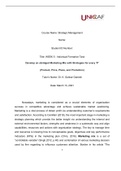Course Name: Strategic Management
Name:
Student ID Number:
Title: WEEK 5 - Individual Formative Task
Develop an abridged Marketing Mix with Strategies for every 'P'
(Product, Price, Place, and Promotion)
Tutor’s Name: Dr. K. Sankar Ganesh
Date: March 13, 2021
Nowadays, marketing is considered as a crucial elements of organization
success in competitive advantage and achieve sustainable market positioning.
Marketing is a vital process of obtain profit via understanding customer’s requirements
and satisfaction. According to Camilleri (2018), the most important stage in marketing is
strategic planning which provide the better insight via understanding the internal and
external environmental factors, strengths and weakness in a systematic way and align
capabilities, resources and actions with organization strategy. The key to manage time
and resources is knowing how to conceptualize goals, objectives and key performance
Indicators (KPIs) in the marketing plan (Chris, 2016). Marketing mix is a set of
“controllable variable” (Singh,2012, p.40) and combination of various marketing decision
used by firm regarding to influence customers attention. Borden in his article “The
1
, concept of marketing mix” (1964), mentioned that marketing mix includes 12 elements
namely: product planning, pricing, branding, channels of distribution, personal selling,
advertising, promotions, packaging, display, servicing, physical handling, and fact
finding and analysis. Later, McCarthy, grouped these elements under four main
elements: product, price, place, and promotion, called the 4Ps (Dang, 2014, p.11).
Following essay will elaborate the importance of 4Ps in a company and exemplify 4Ps
strategies used by Johnson & Johnson.
Marketing mix strategies based on 4Ps lead to the customer’s satisfaction
respecting to navigate marketing efforts in order to enhance the overall organization
performance and create a competitive advantage (Bahador, 2019). Thabit & Raewf
(2018), described that marketing mix propound the role of marketing manager both as a
trader to highlight the competitive strength against others and allocate resources among
various needs and competitive tools of marketing mix. Also, they mentioned some
criticism of marketing mix in their article which mostly related to its theoretical content.
For instance, customers behavior considered as a passive element and there is no
interaction.
Figure 1: 4P s’ (Cited from Dang,2014, p.11)
Shaw (2012, p.34), propound the journey of marketing strategy development in
1950s from Borden (1964) expression of “marketing mix”, Smith’s (1956) “product
differentiation and market segmentation”, later, Dean’s (1951) terms of “skimming”
2




